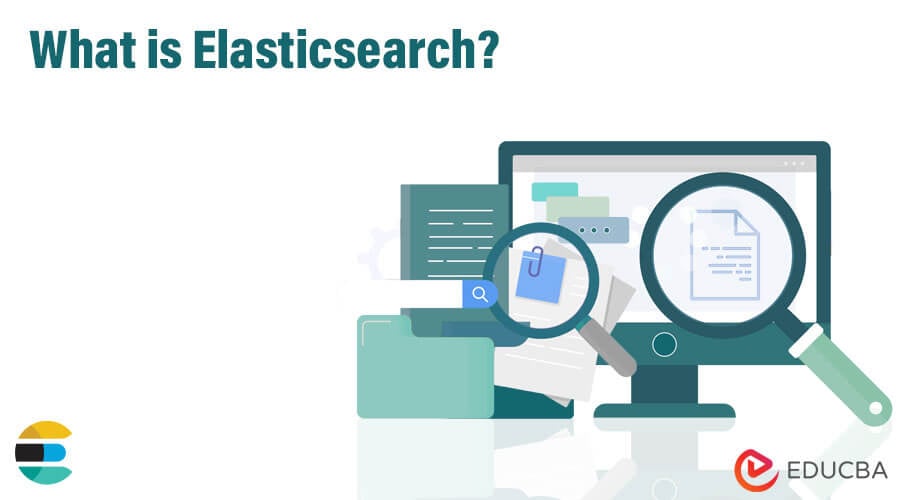Updated March 13, 2023
What is Elasticsearch?
Elasticsearch serves as an open-source, distributed analytics engine and document-oriented database. It allows efficient retrieval, storage, and management of both structured and unstructured data in a scalable and fault-tolerant manner. It stores all data in a JSON document format and supports dynamic mapping, which makes it a schema-less database.
Elasticsearch utilizes the JSON format and offers a domain-oriented Query Language. This allows for nested-level queries tailored to specific requirements. The features of Elasticsearch are exposed through the REST API.
- Index API: Index-level documentation
- Get API: Retrieve the entity at a document level
- Put Mapping API: Override default choices and define the mapping
Key Concepts in Elasticsearch
- Node: It refers to a specific, executing instance of an Elasticsearch setup. A virtual or physical server setup can accommodate one or more nodes. Each node keeps track of various metrics such as RAM usage, storage, and other processing elements.
- Cluster: In Elasticsearch, a cluster consists of connected nodes that distribute search requests across all nodes in the cluster. The cluster also performs collective indexing and searching processes.
- Index: It is a collection of similar documents that share common characteristics—identified by a unique name. Users can perform various operations on the index using this name, such as indexing, searching, updating, and deleting. Elasticsearch also utilizes shards to increase search performance.
- Type/Mapping: In Elasticsearch, a type (or mapping) defines the structure and data types of the fields in a document. When a set of documents share a common set of fields, their definitions can serve as the template for the index, which acts as a table in a traditional relational database.
- Document: It is a JSON object that contains one or more fields, each with a specific data type. Each document is associated with an index value and a type, which determine how the document will be stored and indexed. Additionally, every document receives a unique identifier (UID) that allows easy retrieval and updating.
- Shard: It is a horizontal partition of an index that contains a subset of the index data. Each shard is essentially a self-contained index that holds information about the indexed JSON objects and all the document properties associated with them.
- Replicas: In Elasticsearch, users create replicas of shards to store on different nodes within a cluster. Replicas ensure high data availability in the event of a node failure. By distributing search load across multiple copies of the data, it allows for faster search performance.
What can we do with Elasticsearch?
Here are the uses of Elasticsearch:
- Analytics play a vital role in elastic search. It helps count and summarize the data of any form and volume, especially in big data environments.
- Elasticsearch helps index the documents in the repository and converts log files into storage document format.
- Metrics are episodic counts of system performance data. It can count average CPU usage for the last 30 seconds, memory used by an application, or the primary disk capacity.
- Elasticsearch can store petabytes of data using a large number of servers in the cluster. The complexity of Elasticsearch’s architecture supports this vast data capacity and enables efficient data storage, indexing, and retrieval.
Advantages of Elasticsearch
Below are some of the advantages:
- Allows managing extremely large volumes of data.
- Takes very little time to look for and select the essential data. In comparison, if a normal SQL system takes 20 seconds to search and pull data, then an elastic search would take no more than 10 ms for the same.
- Excellent search engine scalability.
The Target Audience for Elasticsearch
The target audience for elastic search is:
- People interested in learning document storage management.
- Those aspiring for roles related to analytics, data, document storage management, and content repository management.
- Professionals seeking to improve their technical skillset.
Required Skills
The required skills are as follows:
- Experience in handling distributed sets of engine setup
- Statistics experience
- Troubleshooting skills
- Server building activity
- Storage management
- Networking
- Escalation management
Career Options
- Elastic search Admin
- Elastic search Developer
- Document storage Engineer
- Elastic search Consultant
- Elastic search Engineer
Conclusion
Elasticsearch provides a stable environment for storing a large amount of data and content. It allows for extremely fast data retrieval and storage processes. As a result, a wide variety of career opportunities are also emerging around this technology.
Recommended Articles
Here are some further articles related to the subject:



